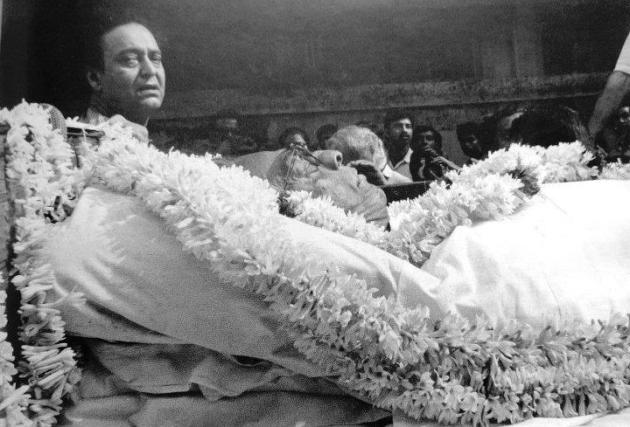On 23rd April 1992, Satyajit Ray, one of India’s most celebrated personalities from the world of cinema, passed away in Calcutta. Twenty one years later, we at TCRC revisit some material on the illustrious life of the iconic Bengali filmmaker.

Satyajit Ray’s funeral. Photo from the newspaper Anandabazar Patrika dated 24th April 1992. Photograph shot by Tarapada Bandopadhyay. Reproduction Courtesy: Riddhi Goswami (found on the Facebook page “FeludaSeries”)
The New York Times published a glowing obituary of Ray, the day after his demise (click here to read the entire obit). The obituary, penned by Peter Flint, recounts how a three-member Oscar committee visited him at Belle Vue Hospital in Calcutta, a month before his death, to present him with the golden statuette for lifetime achievement in cinema. The presentation of the Oscar was filmed and his acceptance speech was screened two weeks later at the Oscars ceremony at the end of March that year.
The NYT obit also showcases a quote from Ray (given below), which beautifully captures how the auteur’s approach to mise-en-scene:
You had to find out yourself how to catch the hushed stillness of dusk in a Bengali village,” he said, “when the wind drops and turns the ponds into sheets of glass dappled by the leaves of the trees, and the smoke from ovens settles in wispy trails over the landscape, and the plaintive blows on conch shells from homes far and wide are joined by the chorus of crickets, which rises as the light falls, until all one sees are the stars in the sky, and the stars blink and swirl in the thickets.”
Interestingly, the Bengali newspaper Anandabazar Patrika didn’t carry a single advertisement on the day after Ray’s death as a mark of respect to the master filmmaker. Well, from where we see it, very few filmmakers today would even be considered worthy of such a tribute and fewer media outlets would be willing to pay such a tribute!
We also loved Dilip Basu’s biography of Ray for the Satyajit Ray Film and Study Center at the University of Southern California, Santa Cruz. Here’s an excerpt (click here to read the entire biography):
How he managed to make the film, pawning his rare music albums, his wife Bijoya’s jewelry and his mother, Suprabha’s networking in the Government circles in Calcutta, has now become a by-word in the annals of Indian film history. It also provides a paradigm on the “modes of production” in the kind of world cinema that stubbornly refuses to kowtow to commercial pressure. The paradigm required a perennial search for the elusive producer; an essential routine of most of Ray’s movie-making career. If he had access to funds for the kind of films he wanted to make on his fiercely independent and nonnegotiable artistic terms, the world would have seen more diversity and many more period pieces in Ray’s oeuvre: films based on ancient epics, the Mughals and the British Colonials. Instead, he limited himself to what was locally available and possible, refusing to stop or give in to commercial presuures. By 1992, the year he passed on, he had made forty films including shorts and documentaries. Some of these are all-time classics, great and near-great films. Unlike his illustrious contemporaries Antonioni, Bergman, Fellini and Kurosawa, for example he never made a film that can qualify as “bad” from the filmmaker’s standpoint.”
